How Artificial Plants Are Redefining Home Decor
Introduction
Our connection to nature remains unwavering in a world that thrives on innovation and constant change. The allure of lush foliage, vibrant blooms, and the tranquility of the outdoors continue to influence our choices, especially regarding interior decor. As we seek to strike a harmonious balance between our modern lifestyles and the beauty of the natural world, a fascinating trend has emerged – the widespread embrace of artificial plants. These meticulously crafted botanical wonders have transcended their humble beginnings to become integral to contemporary decor.
The journey of artificial plants from once-obvious imitations to near-perfect replicas of their living counterparts is a testament to human ingenuity and the constant pursuit of visual authenticity. No longer confined to dusty corners or relegated to the role of mere fillers, today’s artificial plants hold power to transform living spaces into vibrant havens of natural charm. Whether adorning minimalist apartments, eclectic homes, bustling office spaces, or commercial establishments, these faux botanical wonders breathe life into environments that often lack the conditions necessary for the survival of live plants.
The appeal of faux greenery isn’t rooted in a desire to replace live plants but rather in recognising that artificial and real greenery can coexist harmoniously to create a visually stunning and functional decor. By understanding the multifaceted reasons behind the embrace of artificial plants, we gain insights into the evolving dynamics of interior design, environmental consciousness, and the desire for spaces that reflect our modern sensibilities.
By the time we conclude, you’ll have a comprehensive understanding of why artificial plants have captured the hearts of many, adding a touch of the natural world to our homes, workplaces, and hearts.
Table of Contents
The Appeal of Faux Greenery: Why People Are Embracing Artificial Plants
Artificial plants have emerged as a captivating decor trend that fulfils these desires in a world that increasingly values convenience, sustainability, and aesthetic appeal.
In the following exploration, we’ll dissect the various facets of the appeal of faux greenery. We’ll delve into lifelike aesthetics that blur the lines between real and fake, the convenience of low-maintenance allure that fits seamlessly into our fast-paced lives, the endless design possibilities that ignite creativity, and the sustainability and longevity that align with responsible choices.
Lifelike Aesthetics: Bridging the Gap Between Real and Fake
The evolution of artificial plant technology has resulted in natural aesthetics that challenge the boundaries between real and fake greenery.
Gone are the days when artificial plants were immediately identifiable by their plastic appearance. Modern manufacturing techniques, innovative materials, and meticulous attention to detail have brought forth faux greenery that mimics the intricate beauty of nature. From the texture of leaves to the subtle color gradients, these artificial wonders closely resemble their living counterparts, often leaving observers guessing whether they’re real or fake.
The appeal of lifelike aesthetics lies in their ability to create immersive decor that resonates with the calming presence of nature. Artificial plants offer a way to bring the outdoors in, infusing living spaces with vibrancy and beauty, regardless of natural light or maintenance constraints.
Low-Maintenance Allure: Greenery Without the Effort
In our fast-paced lives, the low-maintenance nature of artificial plants offers a compelling solution for those seeking the beauty of greenery without the time and effort associated with live plants.
While the allure of live plants is undeniable, only some have the time or inclination for regular watering, pruning, and care. This is where the convenience of artificial plants shines. With faux greenery, there’s no need to worry about light conditions, watering schedules, or keeping pests at bay. The occasional dusting or cleaning is required to maintain their beauty.
For busy professionals, frequent travelers, or anyone seeking a hassle-free decor option, artificial plants provide the perfect balance between visual appeal and low maintenance. They offer the joy of greenery without the demands of traditional plant care, making them an attractive choice for those seeking a harmonious blend of aesthetics and practicality.
Allergy-Friendly Decor: Creating a Healthy Indoor Environment
For those plagued by allergies or concerned about air quality, artificial plants offer an effective way to enjoy the beauty of greenery without triggering sensitivities.
Indoor allergies can be a significant concern for many. Pollen and other allergenic particles produced by real plants can exacerbate symptoms and compromise air quality. Artificial plants provide an allergy-friendly alternative, ensuring that your living space remains a sanctuary for those with sensitivities. By eliminating the need for natural soil, water, and sunlight, fake plants offer an attractive solution for maintaining a healthy indoor environment.
Endless Design Possibilities: Versatility Unleashed
Artificial plants offer design possibilities that cater to various tastes, styles, and spaces.
The versatile nature of artificial plants allows for creativity to flourish. From small potted arrangements to grand statement pieces, the design options are limited only by imagination. Whether you’re aiming for a minimalistic modern look, a bohemian oasis, or a vibrant tropical paradise, an artificial plant can seamlessly integrate into your decor vision.
Their versatility extends to spaces where live plants might struggle to thrive, such as dimly lit areas or commercial environments. Artificial greenery enables you to curate stunning decor arrangements in spaces that were once considered challenging for live plants.
Sustainability and Longevity: A Thoughtful Choice
Sustainability is a growing concern, and artificial plants offer an environmentally conscious alternative. Their durability and longevity mean fewer replacements, reducing the demand for continuous plant production. Some high-quality artificial plants are made from recycled or recyclable materials, further contributing to their eco-friendly appeal.
Choosing artificial plants with a minimal environmental impact aligns with a responsible approach to decor choices. The lasting beauty they bring to your living spaces is coupled with a sense of ethical consideration for the planet.
Choosing Quality: Factors to Consider When Buying Fake Plants
Selecting the right artificial plants involves more than just picking what looks good. With myriad options available, it’s essential to consider several key factors to ensure that you’re investing in high-quality faux greenery that will enhance your decor for years to come.
Material Realism: Lifelike Textures and Details
The texture and details of artificial plants play a significant role in determining their authenticity and overall visual appeal.
Material realism is one of the first things to examine when choosing fake plants. High-quality artificial plants are crafted with meticulous attention to detail, replicating the textures and subtleties of real leaves, petals, and stems. Gently run your fingers over the foliage – does it mimic living plants’ natural touch and feel? Are there intricate details like veins on leaves, fine filaments on blossoms, or natural variations in color?
Realistic materials contribute to the plant’s visual authenticity and enhance its tactile appeal, making it difficult for observers to distinguish between the artificial and the real. By prioritizing material realism, you ensure that your faux greenery integrates into your decor.
Color Variations and Gradients: Natural Hues that Impress
The color palette of artificial plants should replicate the nuanced shades and gradients present in nature, adding depth to their appearance.
Mother Nature isn’t confined to a single shade of green, nor should your faux plants be. The best fake plants embrace a range of colors that mirror the vibrant variations found in natural foliage. From deeper greens to lighter hues and the transitions between them, these subtle color variations enhance the plant’s lifelike charm.
When evaluating potential purchases, observe how well the artificial plant captures the natural color gradients. The interplay of these hues adds depth and dimension to the plant’s appearance, making it a convincing addition to your decor.
Durability and UV Resistance: Withstanding the Test of Time
Durability and UV resistance are essential qualities determining how well your artificial plants will age and maintain their appearance.
Artificial plants must withstand the test of time indoors and, in some cases, outdoors. Look for plants with durable materials that can resist wear and maintain their shape even when accidentally bumped or brushed. Additionally, if you plan to place your faux greenery in areas exposed to sunlight, ensure they are UV-resistant. UV resistance prevents fading and ensures that your artificial plants remain vibrant and true to their colors over the years.
By prioritizing durability and UV resistance, you’re investing in artificial plants that will continue to enhance your decor long after their initial purchase.
Verifying Vendors: Researching Reliable Brands
With many options flooding the market, thorough research into reputable vendors is essential to make an informed purchasing decision.
Before making a purchase, invest time in researching the vendors and brands. Read customer reviews and testimonials to get an insight into the quality and durability of their products. Trusted brands often have a track record of delivering realistic, high-quality faux greenery. Additionally, their commitment to customer satisfaction is reflected in clear return policies and warranties that offer peace of mind.
Decorating with Faux Greenery: Creative Ideas for Incorporating Artificial Plants
Faux greenery has emerged as a versatile and low-maintenance option for enhancing interior decor. Beyond the traditional pot-on-a-stand approach, a world of creative possibilities is waiting to be explored. Let’s delve into imaginative ways to incorporate artificial plants into your living spaces, infusing them with beauty, charm, and a touch of nature’s tranquility.
Styling Statement: Using Large Artificial Trees as Focal Points
Large artificial trees can serve as breathtaking focal points, transforming ordinary spaces into stunning showcases of nature’s grandeur.
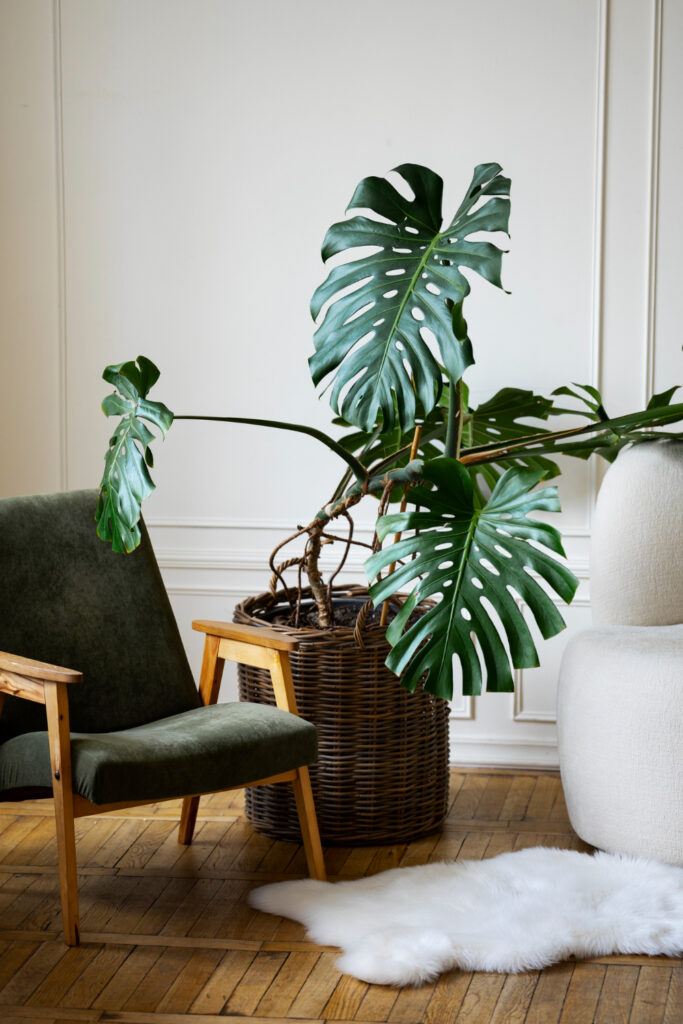
Image Credit: Freepik
Elevate the grandeur of your living room or foyer by incorporating a large artificial tree. These statement pieces not only create a visual impact but also add an element of serenity to your surroundings. Place a realistic artificial palm tree in a corner or beside a seating arrangement to evoke a tropical oasis, or opt for a graceful indoor faux olive tree to infuse Mediterranean charm into your decor.
Shelf Scenery: Elevating Shelves and Bookcases with Miniature Gardens
For those with limited floor space, adorning shelves and bookcases with artificial plants is a brilliant way to bring the outdoors indoors.

Photo by Ksenia Chernaya
When space is at a premium, maximize the vertical dimension of your room by transforming shelves and bookcases into miniature gardens. Arrange a mix of faux potted plants, cascading vines, and petite succulents along the shelves to create an enchanting display that draws the eye upward. The diverse textures and shades of green will add depth to your decor while infusing a touch of nature into every nook and cranny.
Vertical Delights: Adorning Walls with Hanging Artificial Vines
Vertical gardens, also known as living walls, are a captivating way to bring the vibrancy of faux greenery to new heights.
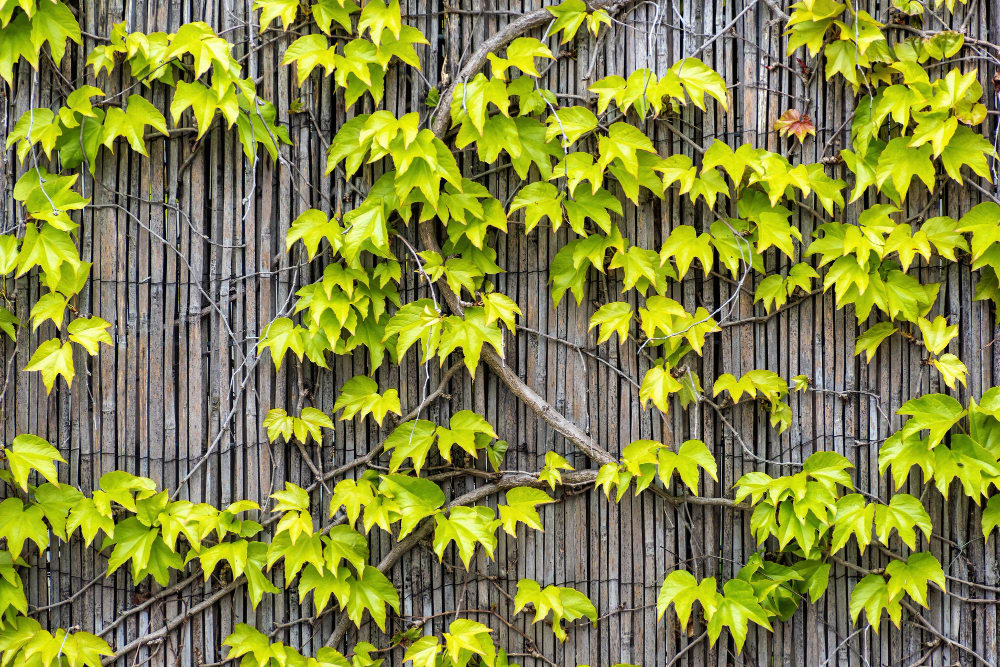
Image by wirestock on Freepik
Vertical spaces often need to be utilized more in interior decor. Enter vertical gardens, an innovative concept transforming walls into living, breathing art installations. By arranging artificial plants in carefully designed patterns, you can create a display that captures the essence of nature. This approach is particularly effective in spaces with limited floor area, adding a dynamic and refreshing element that draws the eye upward.
From lush ivy cascades to intricate arrangements of succulents and ferns, the possibilities are limited only by your imagination. Vertical gardens not only enliven your decor but also showcase your creative prowess.
Desktop Decor: Bringing Nature to Workspaces and Desks
Injecting a bit of greenery into workspaces and desks can uplift the mood and productivity, and artificial plants provide an effortless way to achieve this.
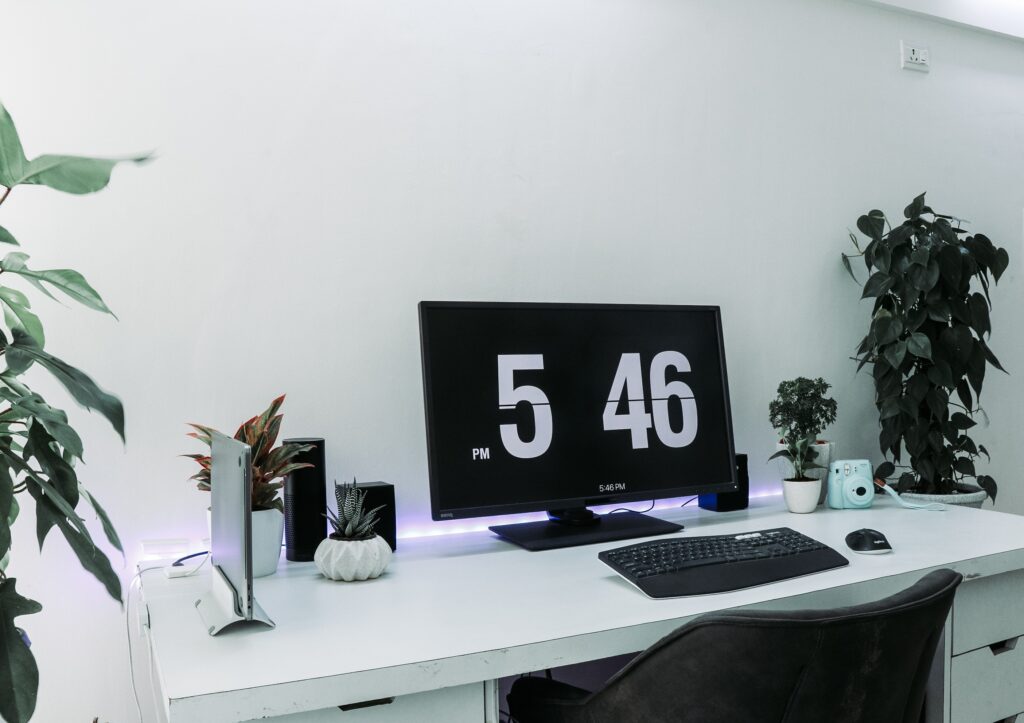
Photo by Sanni Sahil
Enhance your workspace with the refreshing presence of artificial plants. Miniature potted plants or succulents can find a comfortable spot on your desk, adding a touch of nature to your daily grind. These small yet impactful arrangements not only improve the aesthetics of your workspace but also promote a calming atmosphere that fosters creativity and focus.
Terrariums and Cloches: Miniature Ecosystems of Beauty
Terrariums and cloches offer an opportunity to craft miniature ecosystems of artificial plants that evoke curiosity and wonder.
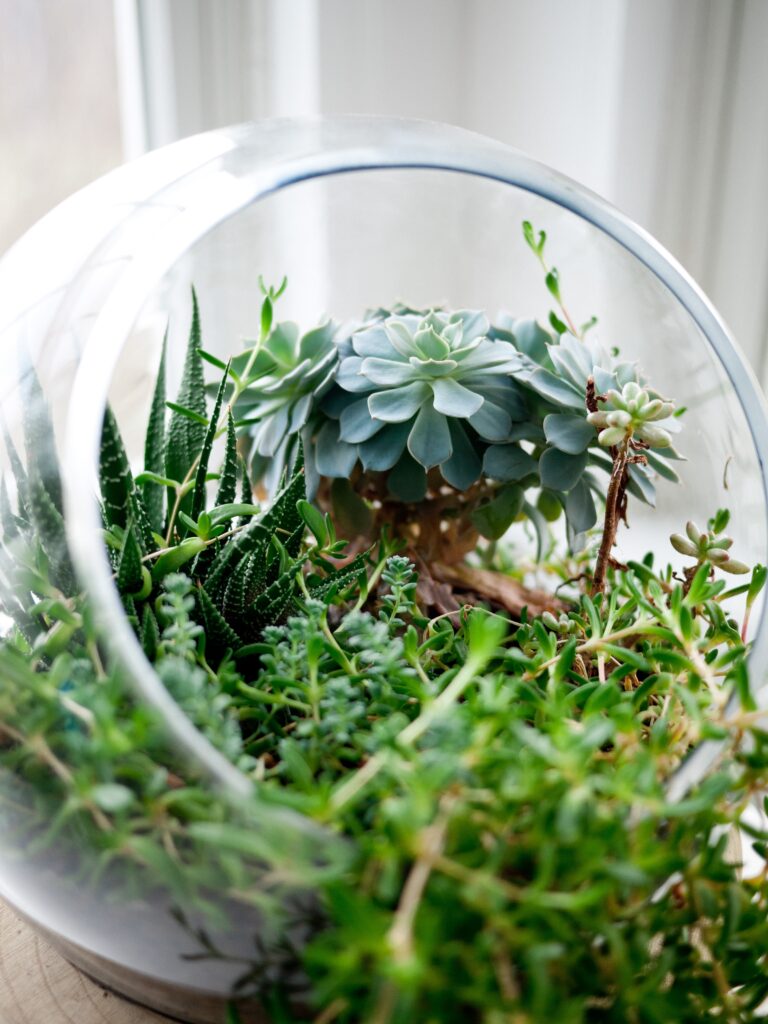
Photo by Jeff Sheldon on Unsplash
Terrariums, those captivating glass vessels encapsulating miniature landscapes, are perfect for showcasing the delicate charm of artificial plants. Whether it’s a desert-themed arrangement with succulents or a lush woodland scene with ferns, moss, and tiny figurines, these self-contained ecosystems bring a touch of enchantment to any space.
Similarly, cloches, or glass domes, create an element of intrigue by enclosing single or small clusters of artificial plants.
Wreaths and Garlands: Seasonal Beauty That Lasts
Faux greenery is a perfect medium for crafting wreaths and garlands that celebrate different seasons and occasions.
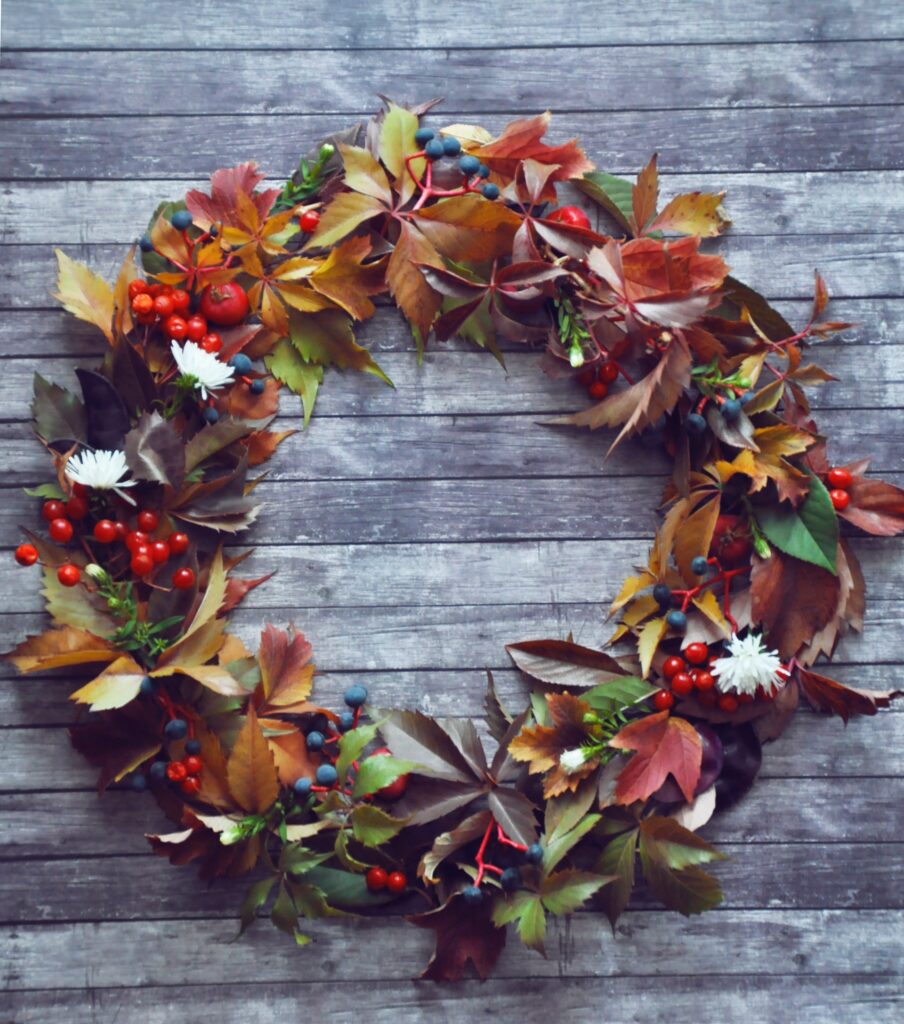
Photo by Евгений Дмитриев on Unsplash
Traditional wreaths and garlands made from live foliage have a limited lifespan, often requiring replacement as they wither. Faux greenery offers a practical solution by providing wreaths and garlands that remain evergreen throughout the year. From festive holiday arrangements to vibrant spring motifs, these versatile decor pieces inject a sense of seasonal charm into your living spaces.
Hang a lush artificial wreath on your front door to welcome guests with timeless elegance, or drape a garland along a fireplace mantel to create a cozy ambiance. With artificial wreaths and garlands, you can enjoy the beauty of each season without the hassle of constant upkeep.
The Ethics of Faux: Sustainability and Environmental Considerations
In an era marked by increased awareness of environmental issues, examining the sustainability implications of every choice we make is crucial. Artificial plants have gained popularity for their aesthetics and low-maintenance nature, but what about their environmental impact?
Let’s dive into the ethics of faux plants, exploring the intricate web of sustainability and environmental considerations surrounding them.
The Carbon Footprint of Live Plants: Transportation and Maintenance
While live plants contribute to environmental well-being, their cultivation, transportation, and maintenance also come with ecological costs.
It’s undeniable that live plants play a vital role in the environment. However, growing, transporting, and maintaining these plants isn’t without its carbon footprint. Consider the energy-intensive practices involved in greenhouse cultivation, long-distance transportation, and applying fertilizers and pesticides. These activities can contribute to greenhouse gas emissions and water pollution.
In this context, faux plants emerge as an alternative with potential environmental advantages. They minimize the need for continuous plant production, transportation, and the resources associated with keeping live plants healthy. Reducing demand for new plants can translate into a smaller ecological footprint.
Longevity and Sustainability: How Fake Plants Reduce Demand
The durability and longevity of artificial plants offer a compelling angle when discussing sustainability, as they reduce the demand for continuous plant production.
Unlike live plants, which might require replacement due to adverse weather, pests, or neglect, well-crafted artificial plants can endure over time. This longevity lessens the frequency of plant production and the associated resource consumption. As a result, the demand for new plants is reduced, leading to potential environmental benefits.
By investing in high-quality faux greenery, individuals can indirectly contribute to conservation efforts by curbing the demand for live plant production, which often requires water, land, and energy resources.
Recycling and Responsible Disposal of Artificial Plants
The sustainability loop still needs to address the responsible disposal or recycling of artificial plants.
Responsible disposal becomes a paramount consideration when it’s time to part ways with your artificial plants. While some components, such as plastics and metals, can be recycled, the overall recyclability of faux greenery depends on the materials used in their construction. It’s crucial to explore local recycling facilities that accept these materials.
Additionally, repurposing or upcycling artificial plants can extend their lifespan and contribute to reducing waste. Creativity comes into play here, as elements of faux greenery could find new life as art installations, craft materials, or even unique decor pieces.
Balancing Aesthetics and Environmental Impact
As you weigh the ethics of faux plants, it’s essential to balance aesthetics and environmental impact.
The decision to incorporate artificial plants into your decor involves a trade-off between the visual appeal they bring and the potential environmental consequences. While artificial plants can offer sustainability benefits by reducing demand for live plants and conserving resources, they also involve using materials that might not be easily recyclable.
When evaluating the ethics of faux plants, consider the larger context of your lifestyle, decor choices, and the overall impact you’re striving to achieve. A thoughtful approach involves understanding the nuances of both sides and making an informed decision that aligns with your values and priorities.
Maintenance Made Simple: Caring for Artificial Plants to Ensure Longevity
While artificial plants require less maintenance than their live counterparts, some care can go a long way in preserving their lifelike beauty over the years. Let’s delve into the world of artificial plant care, exploring the techniques and practices that will keep your faux greenery looking vibrant and fresh.

Image by drobotdean on Freepik
Dusting and Cleaning Techniques: Keeping Your Faux Greenery Vibrant
Regular cleaning is essential to prevent dust buildup and maintain the vibrant appearance of your artificial plants.
Like any other decor element, artificial plants can accumulate dust over time, diminishing their visual appeal. Regular dusting is a simple yet effective way to keep your faux greenery looking vibrant. Using a soft microfiber cloth or a gentle duster, gently wipe down the leaves and stems to remove dust particles. Be sure to reach all areas, including hard-to-reach spots between leaves and intricate details.
Use gentle strokes to avoid bending or damaging the delicate leaves when dusting. It’s advisable to start from the top and work your way down to prevent dislodged dust from settling on already-cleaned areas.
Reviving the Shine: Polishing Leaves and Clearing Grime
Over time, artificial plants might accumulate grime that dulls their sheen. A periodic deep cleaning routine can help restore their radiant appearance.
While dusting keeps your faux plants presentable, occasional deep cleaning is necessary to remove accumulated grime and restore their shine. To do this:
- Create a gentle cleaning solution by mixing mild dish soap with warm water.
- Dip a sponge or soft cloth into the solution, wring it out well, and then carefully wipe down the leaves and stems.
- Avoid excessive moisture, as some faux plants might have materials that are sensitive to water.
- After cleaning with the soapy solution, rinse the cloth thoroughly and wipe down the leaves again to remove any soap residue.
- Finally, use a dry, soft cloth to pat the leaves and stems dry, preventing water spots or streaks from forming.
Storing Tips: Properly Storing Artificial Plants When Not in Use
Proper storage techniques are important for maintaining the shape and quality of your artificial plants, especially during seasonal changes or when they’re not in use.
Proper storage is essential if you’re transitioning between different seasonal decor arrangements or storing your artificial plants for an extended period. The goal is to prevent dust accumulation, maintain the shape of the foliage, and ensure the longevity of your faux greenery.
Invest in protective covers or cases: These prevent dust from settling on the leaves and help retain the plant’s shape during storage. You can find covers designed specifically for artificial plants in various sizes.
Choose a cool, dry storage location: Avoid storing your faux plants in areas exposed to direct sunlight or excessive humidity. Opt for a cool, dry place like a closet or storage room.
Avoid bending or folding leaves: When storing your artificial plants, prevent any bending, folding, or creasing of the leaves and stems. These deformities can be challenging to reverse.
Label or photograph arrangements: If you’re disassembling intricate arrangements, take photos or label the stems to remember their placement when reassembling.
By following these storage tips, you can ensure that your artificial plants emerge from their hibernation looking as fresh and vibrant as when you first brought them into your decor.
Combating Common Criticisms: Addressing Concerns About Fake Plants
While the allure of fake plants continues to grow, it’s essential to address the common criticisms and misconceptions surrounding them. By dispelling these concerns, we can better understand the value and versatility that artificial greenery brings to modern interior decor.
Overcoming Tackiness: Modern Designs and Realistic Options
One of the most persistent criticisms of fake plants is their historical association with subpar designs and tackiness. Let’s explore how contemporary options have successfully broken free from these stereotypes.
In the past, fake plants were often considered an eyesore due to their artificial appearance. However, the evolution of manufacturing techniques has led to a dramatic shift in the aesthetics of artificial greenery. Today, a wide array of realistic options is available, each meticulously crafted to mimic the beauty and intricacies of real plants. These modern designs replicate the texture, color, and even minute details of leaves and petals, resulting in an astonishingly lifelike appearance that can seamlessly blend into any decor style.
From sleek succulents to elegantly cascading ferns, the variety of artificial plants now mirrors the diversity found in nature. As a result, the once-common critique of tackiness has been replaced by an appreciation for the artistic precision and tasteful designs that characterize the best fake plants on the market.
The Environmental Angle: Weighing the Pros and Cons
Another criticism often raised against artificial plants revolves around environmental concerns. However, a balanced view of their ecological impact unveils a more nuanced perspective.
Some artificial plants are indeed manufactured using plastics, contributing to concerns about their environmental footprint. On the other hand, it’s crucial to consider the broader picture. The cultivation and transportation of live plants also come with their own set of ecological consequences, including greenhouse gas emissions and the use of pesticides and fertilizers. Additionally, the durability and longevity of artificial plants reduce the need for constant replacements, thus curbing demand for new plant production and its associated resource consumption.
When deciding between real and artificial plants, considering factors like the life cycle assessment, maintenance requirements, and personal priorities allows for a more informed decision. In many cases, the benefits of artificial plants extend beyond aesthetics to include a positive ecological impact when chosen thoughtfully.
Real vs. Fake: Dispelling the Myth of an All-or-Nothing Choice
The dichotomy between real and fake plants often gives rise to the notion of an all-or-nothing choice. However, understanding the unique advantages of each type can lead to a harmonious integration that enhances your decor.
The debate between real and fake plants need not be polarizing. Both options have their merits, and striking a balance between them can lead to a dynamic and captivating indoor environment. Real plants bring the benefits of natural air purification, humidity regulation, and the aesthetic appeal of living organisms. On the other hand, artificial plants thrive in spaces where real plants might struggle due to low light or maintenance constraints.
Consider the specific needs of your living space and your lifestyle when choosing. Incorporating a mix of real and fake plants allows you to enjoy the best of both worlds, creating a decor that looks stunning and contributes to a healthier and more visually pleasing indoor environment.
Faux Plants for Every Lifestyle: Matching Artificial Greenery to Different Needs
As the popularity of faux plants continues to rise, it’s clear that they are not a one-size-fits-all solution. From low-light spaces to frequent movers and corporate environments, artificial greenery offers a versatile and visually pleasing option for various lifestyles and design preferences.
Low-Light Spaces: Selecting Artificial Plants for Dimly Lit Areas
Dimly lit spaces often pose a challenge for traditional live plants, but the best faux plants excel in these environments, infusing life and vibrancy where natural light is limited.
Dark corners, hallways, and rooms with minimal windows can feel dull and lifeless. Enter artificial plants, your solution to bringing the beauty of nature into areas that lack abundant sunlight.
The best faux plants for low-light spaces are carefully designed to thrive in conditions where real plants might struggle. Opt for varieties that feature deep green hues and a range of textures, as these elements add depth to your decor while mimicking the resilience of their living counterparts.
Whether it’s a cluster of realistic-looking snake plants or a collection of artificial ferns, these faux wonders will transform previously overlooked nooks into delightful corners bursting with green vitality.
Travel Enthusiasts’ Delight: Low-Maintenance Decor for Frequent Movers
Maintaining live plants can be challenging for people who are constantly on the move. Enter artificial plants, offering the perfect blend of aesthetic appeal and hassle-free care for the adventurous at heart.
If your wanderlust keeps you constantly moving, tending to live plants might not be feasible. The best fake plants become your decorative companions, ensuring that a touch of greenery follows no matter where your travels take you. With faux greenery, there’s no need to worry about finding plant sitters or returning to wilted foliage.
Compact desktop plants, realistic succulent arrangements, or even elegant orchids – these low-maintenance wonders are your steadfast companions on your journey, requiring only occasional dusting to stay stunningly vibrant.
Office Elegance: Elevating Corporate Spaces with Artificial Flora
Corporate environments often prioritize efficiency over aesthetics, resulting in sterile workspaces. The best fake plants offer a powerful solution by infusing workspaces with the serenity of nature.
Corporate settings can sometimes feel sterile and uninspiring, which is where the best faux plants step in. These artificial wonders bring a touch of tranquility and creativity to boardrooms, cubicles, and common areas. By introducing carefully chosen faux greenery, you’re enhancing aesthetics and contributing to a more conducive work environment.
Elegant arrangements of realistic faux plants can transform a stark office into an oasis of productivity. From stately palm trees to compact desk companions, the options are limitless, enabling you to curate an atmosphere that fosters creativity, collaboration, and a sense of well-being.
Conclusion: Rediscovering Nature’s Beauty Through Artificial Greenery
As we conclude this exploration into the world of artificial plants, it’s clear that the boundaries between real and fake greenery are blurring. With lifelike realism, low-maintenance allure, and many sustainable advantages, faux greenery has carved a distinctive niche in contemporary decor. By understanding their appeal, prioritizing quality, experimenting with innovative decor ideas, and embracing their role in a sustainable lifestyle, artificial plants offer a refreshing and captivating alternative to traditional indoor flora. So go ahead and introduce the beauty of nature into your space with the vibrant elegance of artificial plants.
FAQs About Artificial Plants
1. Are artificial plants suitable for outdoor use?
Absolutely! Many high-quality artificial plants are designed for outdoor use and can withstand various weather conditions. Look for UV-resistant options to ensure their colors remain vibrant.
2. Can I mix artificial and real plants in my decor?
Yes, you can. The combination of both can create a dynamic and visually appealing environment. Real plants offer the benefits of natural air purification, while artificial plants bring low-maintenance aesthetics to the table.
3. How do I clean dusty artificial plants?
Regular dusting with a soft cloth or duster is effective. Use a mild soap and water solution for deeper cleaning, ensuring you rinse thoroughly to prevent residue buildup.
4. What’s the lifespan of high-quality artificial plants?
With proper care, high-quality artificial plants can last several years, even up to a decade or more. Regular cleaning and responsible storage contribute to their longevity.
5. Can I recycle artificial plants?
Depending on the materials used, some components of artificial plants, such as plastics and metals, can be recycled. Be sure to check with local recycling facilities to determine proper disposal methods.
6. Do artificial plants fade in direct sunlight?
While some cheaper options might fade over time, high-quality artificial plants are often designed to resist fading due to UV exposure. Look for UV-resistant coatings when making your purchase.
7. Can I use artificial plants in rooms with low light?
Yes, artificial plants are an excellent choice for low-light areas where real plants might struggle to thrive. They maintain their vibrancy without requiring natural sunlight.

